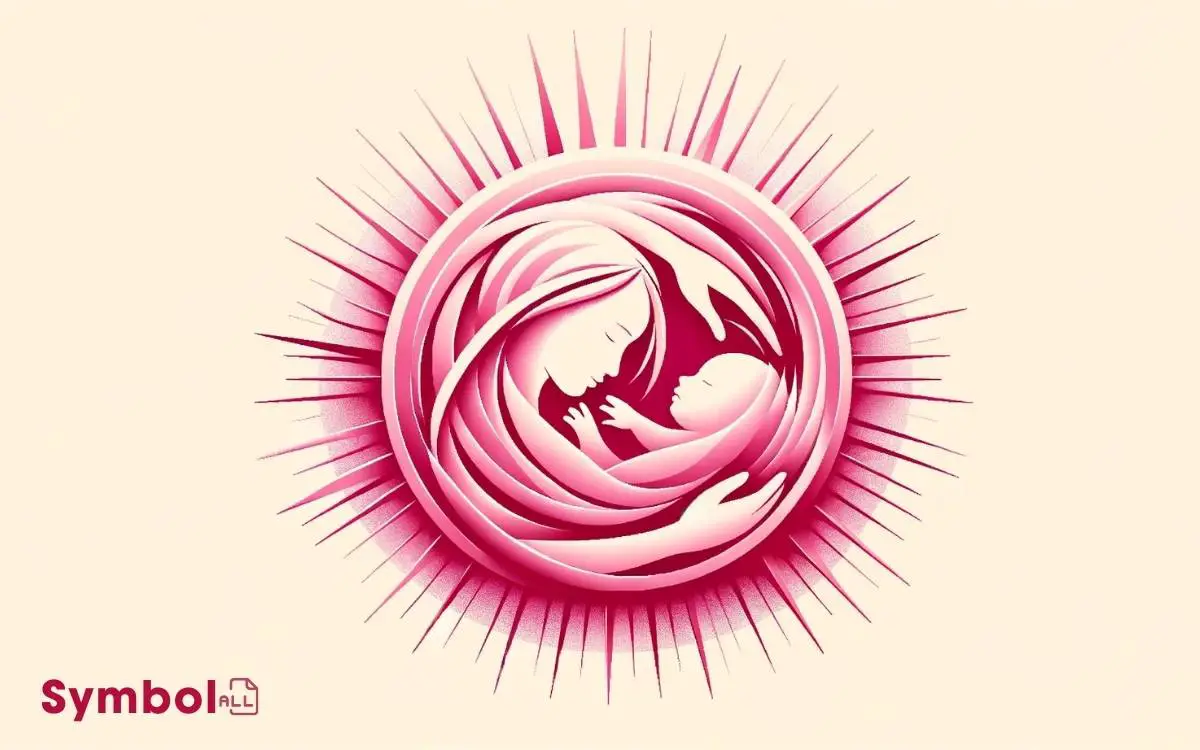What Does the Color Pink Symbolize in the Bible? Joy & Love!
In the Bible, you’ll find pink symbolizes a blend of joy, love, purity, and the promise of renewal. Its connection to red ties it to divine attributes but pink brings its own unique narrative of compassion, healing, and youth.
This color’s rare appearances in scriptures magnify its significance. Its symbolism of divine presence and intimacy speaks to a deeper spiritual understanding. Pink’s role extends to expressing hope, innocence, and the joy of new beginnings.
As you explore this spectrum, you uncover layers of emotional depth and spiritual insight, hinting at a richer grasp of biblical storytelling. This exploration promises to reveal profound connections and enrich your spiritual journey.

Key Takeaway
The Rarity of Pink
In the vast tapestry of biblical narratives, the appearance of pink is remarkably scarce, underscoring its unique significance within this sacred context.
You’ll find that, unlike other colors mentioned with frequency and clarity, pink’s presence is nuanced, often interpreted rather than explicitly stated.
This scarcity isn’t a mere oversight but a deliberate choice, highlighting moments or concepts that the authors deemed exceptional.
You’re invited to ponder how this infrequency shapes your understanding of pink’s role in biblical times. Its limited use prompts a deeper exploration of the occasions it might symbolize, pushing you to look beyond the surface.
This rarity, hence, isn’t just a matter of color preference but a narrative technique, guiding you to uncover layers of meaning in the scripture’s sparing use of pink.
Symbolic Meanings
Exploring the symbolic meanings of pink in the Bible reveals its profound significance when it comes to conveying themes of joy, love, and purity amidst its rare appearances.
This hue, though not frequently mentioned, carries a weight of meaning that enriches your understanding of biblical narratives.
Pink’s association with joy stems from its visual warmth, inviting you to reflect on moments of divine happiness and spiritual fulfillment.
With regard to love, pink embodies the unconditional and sacrificial love highlighted throughout scripture, reminding you of the depth and breadth of divine compassion.
Additionally, its link to purity isn’t just about innocence but also about the cleansing and renewal of the spirit, symbolizing a rebirth into a state of grace and holiness.
This multifaceted symbolism deepens your appreciation for biblical teachings, illustrating the complexity and beauty of spiritual truths.
Pink in Ancient Texts
How does the color pink manifest in ancient texts, and what layers of meaning does it reveal within the tapestry of biblical narratives?
You’ll find that, quite intriguingly, explicit mentions of pink are rare in ancient biblical texts. This scarcity doesn’t diminish its significance, however. Instead, it prompts a deeper exploration into the subtleties of color symbolism in scripture.
Pink, often derived from mixing white (purity, holiness) with red (sacrifice, passion), symbolizes a blend of virtues, embodying the gentle strength of compassion, care, and the dawning of salvation.
Analyzing the use of textiles, minerals, and natural phenomena that hint at pink hues, you uncover a nuanced portrayal of divine love and covenant promises, enriching your understanding of biblical symbolism.
Connection to Red
Building upon the nuanced symbolism of pink in biblical texts, it’s imperative to examine its foundational relationship with the color red, which embodies sacrifice and passion.
Red’s vividness in scripture often signifies the blood of sacrifice and the intensity of divine love, both of which are central to understanding the biblical narrative.
Pink, as a derivative of red, inherits these associations but softens them, suggesting a gentler expression of the same themes.
This connection highlights the continuum of divine attributes, from the fervor of sacrificial love to the gentleness of mercy.
You’ll find this subtle yet profound linkage serves to deepen the interpretive layers of biblical symbolism, offering a richer palette for theological reflection.
Love and Compassion
In the domain of biblical symbolism, pink often embodies love and compassion, demonstrating a nuanced expression of divine tenderness and care. This shade, softer than red, conveys a gentler aspect of affection and benevolence.
You’ll find that, in scriptural contexts, colors play pivotal roles in conveying God’s relationship with humanity.
Pink’s presence subtly underscores a comforting, nurturing aspect of divine love, distinct from the more intense passion or sacrifice suggested by red. This differentiation highlights the multifaceted nature of love as depicted in the scriptures.
It suggests that divine compassion isn’t only about grand gestures of redemption but also encompasses the quiet, everyday acts of kindness and understanding that bind communities and foster spiritual growth.
Femininity and Motherhood
In exploring the color pink in biblical contexts, you’ll find it intricately tied to femininity and motherhood, serving as a symbol of maternal love and the nurturing aspects attributed to women in scripture.
This hue often highlights feminine virtues and the pivotal roles biblical women play, reflecting societal views and theological interpretations of gender.
Through this lens, the narratives of biblical women aren’t just stories but reflections of deeper symbolic meanings tied to pink’s representation of womanhood and maternal care.
Symbolic Maternal Love
The color pink often symbolizes maternal love in the Bible, reflecting femininity and motherhood’s nurturing aspects.
This hue embodies the gentle embrace and essential love characteristic of a mother’s connection with her child.
In biblical texts, pink’s association with maternal love isn’t explicitly stated but inferred through its linkage to softness, care, and compassion—qualities central to motherhood.
This symbolic representation underscores the crucial role of women in biblical narratives as bearers of life and nurturers of the next generation.
Feminine Virtues Highlighted
Building on the symbolic representation of maternal love, it’s important to explore how the color pink in the Bible also underscores feminine virtues, particularly highlighting the interplay between femininity and motherhood.
Pink, often associated with softness and nurture, brings forward the notion of women as bearers of compassion, resilience, and wisdom.
These qualities, deeply embedded in the biblical narrative, reflect a divine appreciation for the feminine spirit.
The color’s gentle hue mirrors the nurturing aspects of motherhood, while also signifying the strength and perseverance inherent in biblical femininity.
This dual symbolism enriches our understanding of scriptural women, portraying them not just as caregivers, but as pivotal figures endowed with a profound capacity for love, guidance, and moral fortitude.
Biblical Womens Roles
Delving into the roles of biblical women, it’s clear that femininity and motherhood aren’t just societal constructs but are deeply woven into the fabric of spiritual narratives, showcasing their pivotal contributions to both family and faith communities.
These roles extend beyond mere reproductive functions, embodying wisdom, leadership, and spiritual guidance.
Women like Sarah, Rebekah, and Mary exemplify strength, resilience, and faith, challenging prevailing norms and influencing divine history.
Their stories reflect a divine acknowledgment of women’s integral roles in nurturing faith and morals within the community.
This analysis reveals that biblical narratives value women’s unique contributions, positioning them as essential to both the spiritual and social fabric, thereby challenging modern perceptions of biblical femininity and motherhood.
The Concept of Covenant
Throughout biblical narratives, covenants serve as foundational agreements that define and shape the relationship between humanity and the divine.
These solemn pacts, often marked by ceremonies or signs, aren’t merely contracts; they’re profound promises that embody faithfulness and commitment.
You’ll observe that in these sacred texts, covenants aren’t taken lightly. They’re imbued with deep symbolism, reflecting God’s unwavering loyalty to His people.
This concept underscores a mutual relationship—where divine provisions are met with human responsibility.
Analyzing these covenants, you’ll find they’re not just historical footnotes; they’re the very framework of biblical faith, illustrating a pattern of divine engagement and human response. Through this lens, the biblical narrative unfolds as a continuous story of commitment and hope.
Healing and Restoration
While the concept of covenant lays the foundation for understanding divine-human relationships, healing and restoration within the biblical texts further illuminate the transformative power of these sacred commitments.
Pink, as it appears in biblical symbolism, often heralds themes of renewal and recovery, embodying the promise of a fresh start or a return to wholeness.
This color’s association with healing isn’t merely about physical wellness but extends to the mending of spiritual and emotional fractures.
It serves as a visual metaphor for God’s desire to restore humanity and creation to their original state of harmony and perfection.
Through this lens, pink becomes a beacon of hope, signifying that renewal is always within reach, irrespective of the depth of one’s brokenness.
Joy and Celebration
You’ll find that pink, within the biblical context, often surfaces amid narratives of joy and celebration. It’s not just a backdrop for festive gatherings; it embodies expressions of happiness and carries a profound religious joy significance.
This color’s presence in such contexts invites a deeper appreciation of its role in conveying divine delight and communal jubilation.
Festive Gatherings
In biblical contexts, the color pink often symbolizes joy and celebration, elements that are prominently featured during festive gatherings.
These gatherings, integral to the fabric of biblical narratives, serve as a canvas where the symbolism of colors unfolds in rich and nuanced layers.
Pink, in particular, emerges as a visual metaphor for the communal joy and shared celebration that characterize these events.
Through its use, the biblical text invites readers into a deeper understanding of the social and spiritual significance of fellowship.
As you explore the scriptural accounts of feasts, weddings, and religious festivals, you’ll notice how pink hues subtly underscore moments of collective joy, binding participants in a shared experience of divine blessing and human connection, thereby enriching the tapestry of biblical storytelling with emotional depth and cultural resonance.
Expressions of Happiness
The Bible’s portrayal of pink not only marks festive gatherings but also deeply embodies expressions of happiness, spotlighting joy and celebration as pivotal themes woven throughout its narratives.
This hue, often linked with softer, more tender moments, serves as a visual metaphor for the spiritual and emotional elation experienced by biblical figures in moments of divine favor or communal unity.
Analyzing these instances, you’ll find that pink’s presence often heralds a shift towards hope and renewal, subtly implying that joy isn’t just an internal state but a communal experience meant to be shared and celebrated.
This perspective invites you to see biblical joy not as fleeting moments of happiness but as profound, collective celebrations of faith and divine grace, deeply embedded in the fabric of spiritual life.
Religious Joy Significance
Exploring the significance of religious joy within biblical narratives reveals a profound layer of spiritual celebration deeply intertwined with faith’s core tenets.
This joy isn’t merely an emotional response but a manifestation of divine grace and favor, symbolized through various means, including color.
Pink, though not explicitly mentioned, can be inferred as a representation of this joy, drawing parallels from its cultural associations with warmth, tenderness, and love.
In biblical context, joy is a sacred state, often linked to divine encounters, miracles, and expressions of God’s love.
It’s a complex emotion, embodying gratitude, peace, and an overwhelming sense of spiritual fulfillment.
Understanding this helps you grasp the multifaceted nature of biblical joy, where it’s not just felt but deeply lived, marking moments of divine closeness and communal celebration.
Youth and Innocence
Many scholars argue that pink symbolizes youth and innocence within biblical narratives, reflecting a nuanced understanding of human development and spiritual purity.
This color often surfaces in contexts highlighting:
- The purity and naivety associated with childhood.
- The initial stages of spiritual awakening and growth.
- Symbolic representations of new beginnings, free from the corruption of worldly experiences.
- The tender, unblemished nature of a soul newly born into faith.
Through this lens, pink isn’t merely a color but a profound symbol representing the earliest stages of life’s journey, both physically and spiritually. It invites readers to reflect on the purity and simplicity of youth, urging a return to innocence in one’s faith and actions.
Divine Presence
In biblical narratives, pink often emerges as a subtle yet powerful symbol of Divine presence, suggesting an intimate connection between the divine and the human spirit.
It’s not just a color; it signifies the ethereal and the sacred, bridging the divide between celestial domains and earthly existence.
This connection is manifest in the warmth and comfort that pink hues can evoke, reminiscent of a divine embrace or a whispered promise of guidance and protection.
| Aspect | Significance |
|---|---|
| Warmth | Divine Comfort |
| Subtlety | Presence in Detail |
| Intimacy | Personal Connection |
Transition and Change
Pink’s representation in the Bible extends to embodying metamorphosis and change, illustrating how this color marks pivotal moments of transformation in the narrative.
As you explore deeper into the biblical text, you’ll find that pink isn’t merely a color but a symbol of significant shifts, both spiritually and physically.
Consider how pink serves as a beacon for:
- The change from despair to hope, signaling a new phase in one’s faith journey.
- The shift from ignorance to enlightenment, marking a profound understanding of divine truths.
- The evolution of chaos into order, reflecting the divine orchestration of life’s complexities.
- The movement from isolation to community, highlighting the importance of fellowship in spiritual growth.
Each instance where pink emerges, it invites you to ponder the dynamic nature of faith and the perpetual journey towards divine alignment.
Purity and New Life
You’ll find that the color pink holds a significant place when exploring the concepts of purity and new life within biblical texts.
Symbolic pink baptisms represent a cleansing and rebirth, paralleling the dawn of creation’s pure light.
This hue subtly underscores the transformative journey from old to new, embodying a sacred renewal inherent in faith’s narrative.
Symbolic Pink Baptisms
Exploring the symbolism of pink in biblical baptisms reveals its deep association with purity and the promise of new life.
Within this framework, pink isn’t just a color; it’s a profound symbol that encapsulates the essence of spiritual rebirth and cleansing. It radiates a sense of hope, compassion, and emotional healing, serving as a bridge between the physical and the divine. The color pink spiritual meaning often ties to the heart chakra, representing love, kindness, and the balance of energies. By embracing pink, one invites a harmonious flow of positivity and renewal into their life.
Consider how pink in baptisms conveys multiple layers of meaning:
- It represents the flushing away of the old, sinful self.
- Signifies the gentle embrace of divine love and forgiveness.
- Symbolizes the heart’s renewal and the soul’s purification.
- Echoes the joy and hope that accompany the believer’s new journey in faith.
This color’s use in such a sacred rite underscores its significance in conveying a transformative spiritual experience that’s both personal and universal.
Through pink, the believer’s path towards purity and new life is vividly illustrated, embodying the profound promises of faith.
Dawn of Creation
In the biblical narrative, the dawn of creation is imbued with symbols of purity and the promise of new life, where the color pink emerges as a poignant emblem of this pristine beginning.
You’ll find that the symbolism of pink in these early passages isn’t just about beauty or aesthetics; it’s deeply intertwined with themes of innocence, renewal, and divine love.
| Aspect | Symbolism | Relevance |
|---|---|---|
| Dawn | New Beginnings | Pink’s soft hues mirror the first light of creation. |
| Purity | Innocence | Reflects the unblemished state of the world. |
| New Life | Growth | Symbolizes the potential for life and prosperity. |
| Divine Love | Unconditional | Pink represents the boundless love of the creator. |
| Renewal | Restoration | Emphasizes the ongoing cycle of life and hope. |
This color’s presence invites you to ponder the profound simplicity and depth of creation’s first moments.
The Rose of Sharon
The Rose of Sharon represents a complex symbol of beauty and love in biblical literature, often associated with the color pink and its inherent symbolism.
This emblem, deeply rooted in spirituality, carries layers of meaning that transcend its immediate visual appeal.
Here’s a closer look:
- It signifies divine love, hinting at an everlasting bond between the divine and humanity.
- The rose’s beauty stands as a metaphor for spiritual beauty and purity.
- Its resilience in harsh conditions symbolizes enduring faith and perseverance.
- The flower’s bloom represents renewal and hope, a reminder of spiritual awakening.
Understanding the Rose of Sharon in this light offers you a richer appreciation of its place in biblical narratives, embodying themes of love, resilience, and spiritual enlightenment.
Reflections in Psalms
As you explore the Psalms, you’ll find that the emotional landscape is intricately woven with divine love imagery, where pink symbolizes a tender, compassionate connection with the divine.
This hue’s presence in Psalms invites you to reflect on how spirituality and emotion interlace, revealing a deeper understanding of faith’s nuances.
Through this lens, the Psalms offer a rich tapestry of human experience, colored by divine love’s enduring presence.
Psalms Emotional Landscape
Exploring the Psalms reveals a complex emotional landscape, where the soul’s deepest cries and highest joys find expression.
This poetic book serves not just as a spiritual guide but as a mirror to the multifaceted human experience.
By delving into its verses, you uncover:
- Lamentations and pleas for mercy, showcasing the vulnerability and desperation in seeking divine intervention.
- Expressions of gratitude and joy, illustrating the heart’s overflowing thankfulness for God’s blessings.
- Cries for justice, reflecting a deep longing for righteousness in a world filled with inequity.
- Moments of introspection and confession, offering a pathway to humility and spiritual renewal.
Analyzing these elements sheds light on the Psalms’ ability to articulate the breadth of human emotion, guiding the faithful through their own spiritual journeys with empathy and understanding.
Divine Love Imagery
Delving into the Psalms, you’ll uncover imagery of divine love that serves as both a refuge and an inspiration, revealing the profound depths of God’s commitment to His people.
This poetic book employs vivid language to depict a God whose love is enduring and multifaceted.
The psalmists articulate this divine affection through metaphors of shelter, guidance, and redemption, portraying God’s love as an immutable force that sustains and nurtures.
As you analyze these passages, you’ll find that the imagery not only encapsulates the essence of divine love but also invites the believer into a deeper, more personal relationship with God.
This exploration highlights the nuanced ways in which the biblical text communicates the complexities of God’s love, affirming its foundational role in the believer’s life.
Conclusion
As you’ve journeyed through the nuanced symbolism of pink in the Bible, you’ve uncovered layers of meaning that stretch beyond mere color.
From its rare appearances to its deep connections with love, purity, and transformation, pink holds a sacred place in biblical texts.
Yet, the true depth of its significance is perhaps still veiled in mystery. As we ponder the Rose of Sharon and reflections in Psalms, we’re left to wonder: what further secrets does pink conceal within the sacred scriptures?
The answer invites a deeper exploration, challenging us to look beyond the surface and into the heart of spiritual symbolism.






